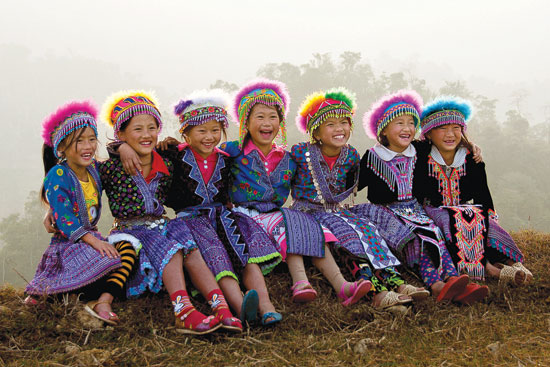No 11, Vol.5, December 2015 – January 2016
The air is filled with the familiar playful sounds of happy pestles pounding steamed sticky rice in mortars. There are also the higher notes of kids’ laughter and shouting during their traditional games of humming-top and pao ball throwing
H’Mong traditional New Year celebration begins on the 30th of 11th lunar month (a month before Vi?t New Year) and lasts 3 days. It’s the time for sharing foods, drinks and fun after a year of continuous hard work.
At the H’Mong New Year’s feast, besides all sorts of meat, paste cake is a must. Women are busy steaming milpa sticky rice, the main ingredient of the cakes. When, finished, the rice is scooped into large wooden mortars and strong young men pound it with long pestles.
It’s harder to pull the pestles up than crush them down. In the brittle cold of winter, the men’s faces turn red, covered in beads of sweat. Soft and smooth dough-like rice is then kneaded in a round shape and wrapped in banana leaves.
When ready, 6 pairs of cakes are arranged neatly on the altar, representing the 12 months of a year, as a tribute to heaven, earth and the god of harvest.
As symbolic as the Vi?t glutinous rice cake, paste cake is the H’Mong New Year’s icon to express gratitude to heaven, earth and their ancestors. It represents the sun and the moon that give birth to people and all living things on earth.
H’Mong people don’t ring New Year in at midnight. To them, it comes with the first cock-crow of the first day of the new year. The men get up, prepare a first meal for the family, and cattle and do all the chores instead of women, because they are the pillars of the household and must make an example of order and discipline that will be kept the whole coming year.
On new year’s day people go around the village to wish each other happiness. The H’Mong are very hospitable, and guests who come on New Year’s day bring luck for the whole year. The hosts treat their guests with everything they have, and invite them to stay overnight. Before leaving, guests are given paste cakes made by the host family as a token of gratitude and wish for happiness.
Another unique H’Mong New Year’s custom is that of gluing paper on their farming tools and putting them near the family altar. It’s the way they show their grattitude to the farming tools for having helped them work their fields and gardens to earn a living for the whole family.
New Year is also a time for H’Mong children to play, for the elders to sit together and talk about their good old times, and for young people to date and get more intimate. So on these days, the mountain slopes brighten with festive colors of new dresses and adornments. Life for them is exuberant.
In the village clearing, people gather to play folk games and enjoy a pipe blowing and dance show. Peacock-like H’Mong young men show off their dancing to attract the glistening black pearls that keep them awake at night the whole year long.
In their best outfits, the young men compete, blowing their bamboo pipes and dancing. The longer the breath, the more flaring the melody, the suppler the dance, the more girls feel moved. Many young couples bond in marriage thanks to the New Year’s celebrations and these deeply ethnic games.
When thick mist falls on the mountains, giving sharp teeth to the cold, everybody gathers around big fires. Nothing can stop the generous hearts from having the fun they deserve. They sit closer to each other, hand in hand, enjoying the songs and dances their ancestors loved and so will their descendants, bonding together in anticipation of a happy new year.n
Hmong children’s New Year. Lai Chau Province, 2015. This photo series won third prize in Vietnam Heritage Photo Awards 2015
Photos by Tran Dao Si.

